Reserve Bank of Australia Annual Report – 2016 Earnings and Distribution
The Reserve Bank's balance sheet fluctuates in size according to operations in financial markets conducted to pursue its monetary policy objectives and support an efficient and orderly payments system in Australia. The Bank earns a profit in most years. It holds reserves that are sufficient to cover potential financial losses. In 2015/16, the Bank recorded a net profit of $2.9 billion, with earnings available for distribution of $4.6 billion.
The Reserve Bank's Balance Sheet
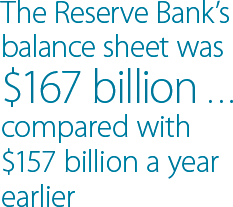
The Reserve Bank holds a range of financial assets to conduct operations in financial markets, to pursue monetary policy objectives and support an efficient and orderly payments system in Australia. Monetary policy is implemented by carrying out transactions in these assets to manage liquidity in the cash market in Australia. The Bank's assets include both Australia's foreign exchange reserves and domestic securities. The Bank's liabilities mainly comprise banknotes on issue, deposits of the Australian Government and other customers, and capital and reserves.
The Reserve Bank's balance sheet was $167 billion on 30 June 2016, compared with $157 billion a year earlier. Banknotes on issue, the Reserve Bank's largest liability, rose by about 7 per cent, to $70 billion. Management of the Bank's assets is discussed in the chapter on ‘Operations in Financial Markets’; the associated risks are considered in the chapter on ‘Risk Management’.
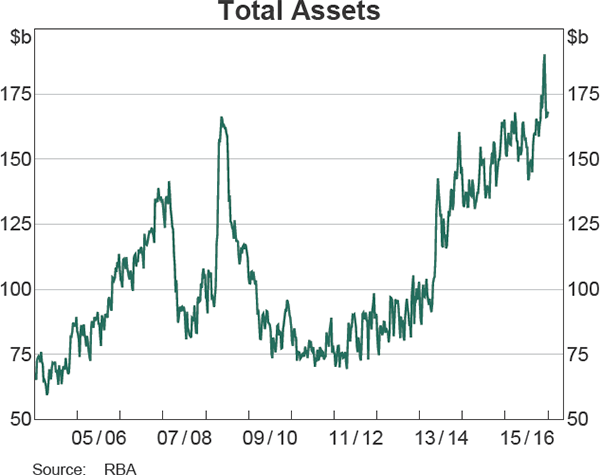
The Reserve Bank's Earnings
The Reserve Bank's earnings in most years arise from two sources: underlying earnings – comprising net interest and fee income, less operating costs – and valuation gains or losses. Net interest income arises because the Bank earns interest on almost all of its assets, albeit currently at very low rates, while it pays no interest on a large portion of its liabilities, such as banknotes on issue and capital and reserves. Fees paid by authorised deposit-taking institutions (ADIs) associated with the Committed Liquidity Facility (CLF) are also a material contributor to underlying earnings.
Valuation gains and losses result from fluctuations in the value of the Reserve Bank's assets, in response to movements in exchange rates or in yields on securities. A depreciation of the Australian dollar or a decline in interest rates results in valuation gains. Conversely, an appreciation of the Australian dollar or a rise in market yields leads to valuation losses. Valuation gains and losses are realised only when the underlying asset is sold or matures. Valuation gains and losses are volatile from year to year, as both exchange rates and market interest rates fluctuate in wide ranges over time. These market risks are managed by the Bank within strict parameters determined by its responsibility for monetary policy.
The Reserve Bank reports net profit as income from all sources in accordance with Australian Accounting Standards, while the distribution of profits is determined by section 30 of the Reserve Bank Act 1959. In terms of the Reserve Bank Act, net profit is distributed in the following way:
- Unrealised gains (or losses) are not available for distribution and are transferred to (absorbed by) the Unrealised profits reserve. The remaining net profit after this transfer is available for distribution.
- The Treasurer determines, after consultation with the Reserve Bank Board, any amounts to be placed from distributable earnings to the credit of the Reserve Bank Reserve Fund (RBRF), the Bank's permanent reserve.
- The remainder of distributable earnings after any transfer to the RBRF is payable as a dividend to the Commonwealth.
In 2015/16, the Reserve Bank recorded a net profit of $2,883 million, comprising:
- underlying earnings of $1,223 million, which were $391 million higher than the previous year because of higher net interest income resulting from a rise in interest-earning assets and a small increase in the interest margin, and the first full-year receipt of CLF fee income, following the introduction of the CLF on 1 January 2015. Excluding CLF fee income, underlying earnings nevertheless remained near a historically low level with interest rates around the world also remaining very low
- total net valuation gains of $1,660 million, mainly because of the depreciation of the Australian dollar during the year. Realised gains amounted to $3,389 million, largely as a result of the sale of foreign currency in the normal course of managing the portfolio of foreign reserves and a re-allocation of foreign currency reserves. These transactions had no effect on the value of the Australian dollar. Realised gains exceeded total valuation gains as realised gains in 2015/16 included gains from sales of assets on which unrealised gains had been recorded in earlier years. As discussed below, the realisation of these gains is associated with a fall in the balance of the Unrealised profits reserve.
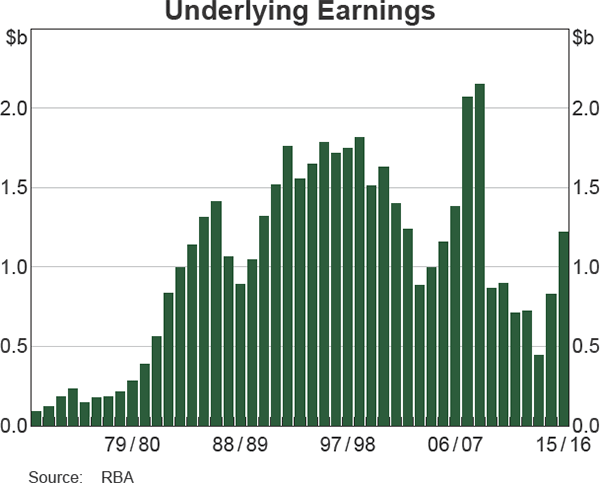
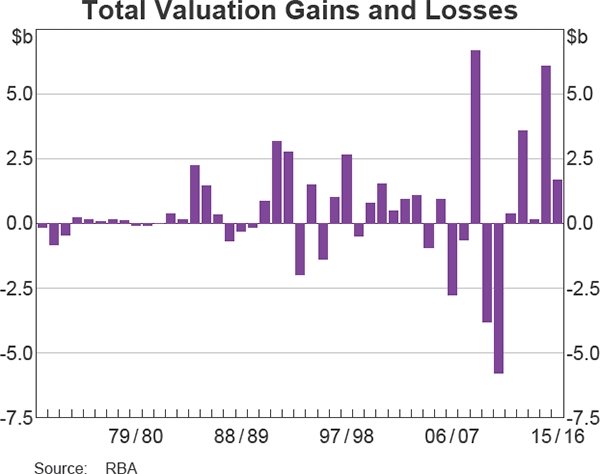
Earnings available for distribution in 2015/16 amounted to $4,612 million, compared with $3,454 million in the previous year. The pattern of net profit over the longer term is shown in the graph on net profits.
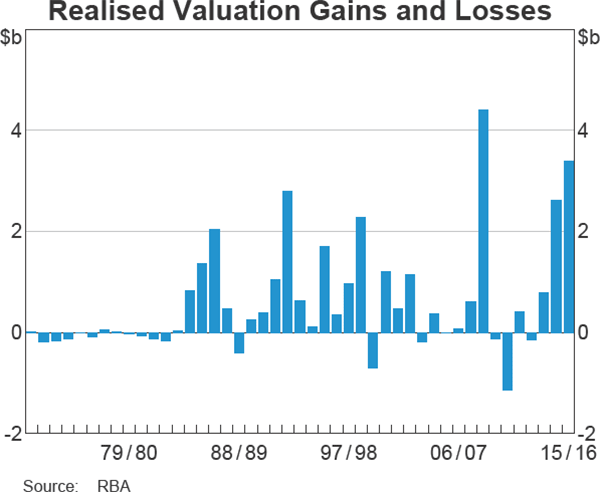
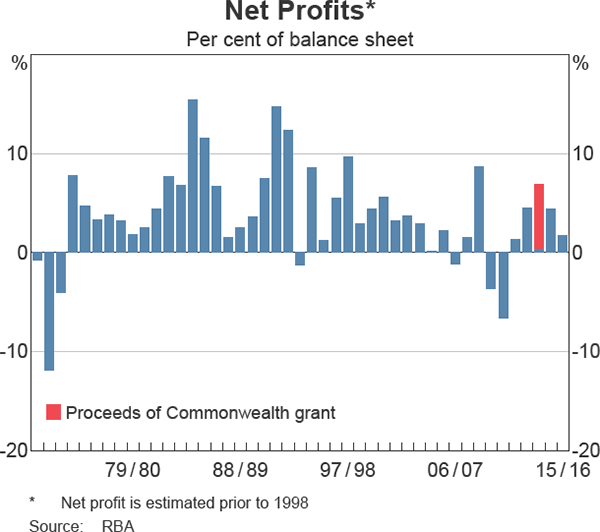
Capital, Reserves and Distribution
The RBRF is the Reserve Bank's general reserve and is essentially its capital. The RBRF is funded from transfers from earnings available for distribution. Its purpose is to provide the capacity to absorb losses when it is necessary to do so, as was the case in 2009/10 and 2010/11, when large valuation losses were recorded following the appreciation of the Australian dollar.
With the Reserve Bank's assets at risk rising further in 2015/16, the Treasurer determined, after consulting the Reserve Bank Board, that a sum of $1,390 million be transferred from earnings available for distribution to the RBRF, to maintain the balance of this reserve at a level consistent with the Board's policy. The balance of the RBRF now stands at $14,119 million. Following this transfer, a sum of $3,222 million was payable as a dividend to the Commonwealth. The Treasurer decided that the full amount of this dividend would be paid to the Commonwealth in 2016/17. During 2015/16, the Treasurer also requested that the second instalment of the dividend payable from 2014/15 profits, a sum of $942 million, which had initially been deferred for payment until the 2016/17 financial year, be paid to the Commonwealth in 2015/16.
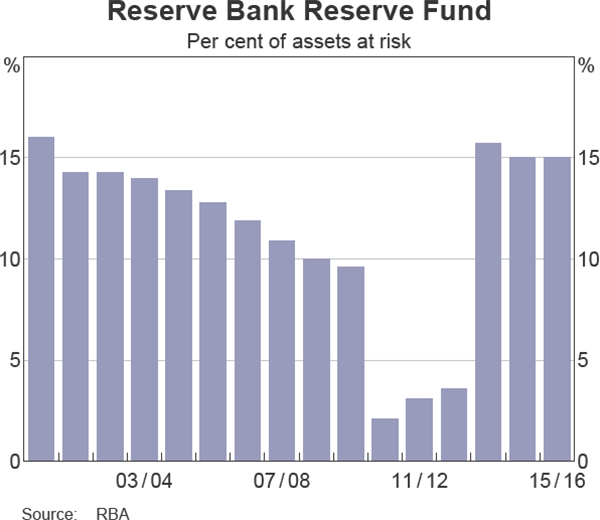

The balance of the Unrealised profits reserve is $4,861 million, a decline of $1,729 million from 2014/15, the movement partly reflecting, as noted, the realisation of gains accumulated from earlier years. The remaining balance of the reserve is available to absorb future valuation losses or can be distributed over time as these accumulated gains are realised when relevant assets are sold, as occurred in 2015/16.
Asset revaluation reserves are held for non-traded assets, such as gold holdings and property, plant and equipment. Balances in these reserves represent the difference between the market value of these assets and the cost at which they were acquired. The total balance for these reserves stood at $5,074 million at 30 June 2016, $698 million higher than at the end of the previous financial year, largely reflecting the increase in the Australian dollar value of the Reserve Bank's holdings of gold.
The balance of the superannuation reserve was a debit of $182 million at 30 June 2016, compared with a credit of $134 million a year earlier.
Details on the composition and distribution of the Reserve Bank's profits are contained in the following table.
The Financial Statements (and accompanying Notes to the Financial Statements) for the 2015/16 financial year were prepared in accordance with Australian Accounting Standards, consistent with the Finance Reporting Rule issued under the Public Governance, Performance and Accountability Act 2013.
| Composition of profits(a) | Distribution of profits | Payments to government | |||||||||
|---|---|---|---|---|---|---|---|---|---|---|---|
| Transfer to/from(−) | |||||||||||
| Underlying earnings | Realised gains and losses(−)(b) | Unrealised gains and losses(−) | Accounting profit or loss(−) | Unrealised profits reserve | Asset revaluation reserves | Reserve Bank Reserve Fund | Dividend payable | Payment from previous year's profit | Payment delayed from previous year | Total payment | |
| 1997/98 | 1,750 | 966 | 1,687 | 4,403 | 1,687 | −558 | 548 | 2,726 | 1,700 | – | 1,700 |
| 1998/99 | 1,816 | 2,283 | −2,773 | 1,326 | −2,349 | −1 | – | 3,676 | 2,726 | – | 2,726 |
| 1999/00 | 1,511 | −708 | 1,489 | 2,292 | 1,489 | – | – | 803 | 3,000 | – | 3,000 |
| 2000/01 | 1,629 | 1,200 | 320 | 3,149 | 320 | −5 | _ | 2,834 | 803 | 676 | 1,479 |
| 2001/02 | 1,400 | 479 | −11 | 1,868 | −11 | −10 | – | 1,889 | 2,834 | – | 2,834 |
| 2002/03 | 1,238 | 1,157 | −222 | 2,173 | −222 | −2 | 133 | 2,264 | 1,889 | – | 1,889 |
| 2003/04 | 882 | −188 | 1,261 | 1,955 | 1,261 | – | – | 694 | 1,300 | – | 1,300 |
| 2004/05 | 997 | 366 | −1,289 | 74 | −1,289 | – | – | 1,363 | 374 | 964 | 1,338 |
| 2005/06 | 1,156 | 4 | 933 | 2,093 | 933 | −17 | – | 1,177 | 1,063 | 320 | 1,383 |
| 2006/07 | 1,381 | 72 | −2,846 | −1,393 | −2,475 | −3 | – | 1,085 | 1,177 | 300 | 1,477 |
| 2007/08 | 2,068 | 614 | −1,252 | 1,430 | 27 | – | – | 1,403 | 1,085 | – | 1,085 |
| 2008/09 | 2,150 | 4,404 | 2,252 | 8,806 | 2,252 | – | 577 | 5,977 | 1,403 | – | 1,403 |
| 2009/10 | 866 | −128 | −3,666 | −2,928 | −2,248 | – | −680 | – | 5,227 | – | 5,227 |
| 2010/11 | 897 | −1,135 | −4,651 | −4,889 | −23 | – | −4,866 | – | – | 750 | 750 |
| 2011/12 | 710 | 405 | −39 | 1,076 | −20 | – | 596 | 500 | – | – | – |
| 2012/13 | 723 | −135 | 3,725 | 4313 | 3,725 | – | 588 | – | 500 | – | 500 |
| 2013/14 | 9,242(c) | 790 | −640 | 9,392 | −640 | −3 | 8,800 | 1,235 | – | – | – |
| 2014/15 | 832 | 2,622 | 3,434 | 6,888 | 3,434 | – | 1,570 | 1,884 | 618 | – | 618 |
| 2015/16 | 1,223 | 3,389 | −1,729 | 2,883 | −1,729 | – | 1,390 | 3,222 | 1,884 | 618 | 2,501 |
| 2016/17 | 3,222 | – | 3,222 | ||||||||
|
(a) As originally publishec |
|||||||||||